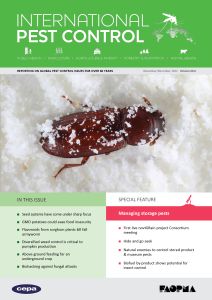Eco Bed Bug Exterminators Dc Things To Know Before You Get This
Eco Bed Bug Exterminators Dc Things To Know Before You Get This
Blog Article
Eco Bed Bug Exterminators Dc Fundamentals Explained
Table of ContentsThe smart Trick of Eco Bed Bug Exterminators Dc That Nobody is DiscussingUnknown Facts About Eco Bed Bug Exterminators DcHow Eco Bed Bug Exterminators Dc can Save You Time, Stress, and Money.Eco Bed Bug Exterminators Dc Things To Know Before You Get ThisIndicators on Eco Bed Bug Exterminators Dc You Should Know
Due to the fact that pesticides are poisonous, they are also potentially unsafe to people, animals, various other microorganisms, and the atmosphere. Therefore, individuals who utilize pesticides or frequently been available in call with them have to understand the relative toxicity, potential health results, and preventative procedures to decrease direct exposure to the products they use. Risk, or danger, of using pesticides is the potential for injury, or the degree of risk associated with utilizing a pesticide under an offered collection of conditions.
However, applicators can lessen or almost remove direct exposure-- and therefore lower hazard-- by adhering to the tag directions, making use of individual safety apparel and tools (PPE), and dealing with the chemical appropriately. As an example, more than 95 percent of all chemical direct exposures come from dermal direct exposure, mainly to the hands and forearms. By putting on a set of unlined, chemical-resistant handwear covers, this kind of direct exposure can be virtually gotten rid of.
The dangerous results that happen from a single direct exposure by any path of entry are labelled "intense results." The 4 routes of exposure are dermal (skin), inhalation (lungs), oral (mouth), and the eyes. Severe toxicity is determined by taking a look at the facial poisoning, inhalation poisoning, and oral poisoning of test animals.
Eco Bed Bug Exterminators Dc Fundamentals Explained
Intense poisoning is measured as the amount or focus of a toxicant-- the a.i.-- needed to eliminate half of the pets in a test population. This action is normally expressed as the LD50 (dangerous dose 50) or the LC50 (deadly concentration 50). Additionally, the LD50 and LC50 worths are based upon a single dosage and are tape-recorded in milligrams of pesticide per kilo of body weight (mg/kg) of the test animal or in components per million (ppm).
The reduced the LD50 or LC50 worth of a chemical product, the greater its poisoning to human beings and pets. Pesticides with a high LD50 are the least hazardous to humans if utilized according to the directions on the product tag. The chronic toxicity of a chemical is identified by subjecting examination pets to long-lasting exposure to the active ingredient.
The persistent toxicity of a chemical is harder than intense poisoning to identify via research laboratory evaluation. Products are categorized on the basis of their relative acute poisoning (their LD50 or LC50 worths). Chemicals that are identified as highly hazardous (Toxicity Category I) on the basis of either oral, dermal, or breathing poisoning need to have the signal words DANGER and poisonous substance printed in red with a head and crossbones sign plainly showed on the front panel of the package label.
The acute (solitary dose) oral LD50 for chemical items in this team ranges from a trace amount to 50 mg/kg. Direct exposure of a couple of decreases of a product taken orally can be deadly to a 150-pound person. https://www.tumblr.com/ecobedbug3xt/745403336317173760/established-in-2007-eco-bed-bug-exterminators-dc?source=share. Some chemical products have just the signal word DANGER, which tells you absolutely nothing about the intense toxicity, simply that the item can cause extreme eye damage or serious skin irritation
The Basic Principles Of Eco Bed Bug Exterminators Dc
In this classification, the acute dental LD50 ranges from 50 to 500 mg/kg. A tsp to an ounce of this product might be deadly to a 150-pound person (bed bug heat treatment). Chemical products categorized as either somewhat toxic or fairly harmless (Poisoning Groups III and IV) are needed to have the signal word CAUTION on the pesticide tag

All pesticide toxicity chemical, including the Consisting of, can be found on discovered product's Item Safety Data Safety and security (MSDS). Pesticide labels and MSDS can be obtained from sellers or produces - https://justpaste.it/dmzm0. The signs and symptoms of pesticide poisoning can range from a mild skin irritation to coma or even death.
Because of potential health and wellness problems, pesticide customers and trainers have to see this website identify the typical signs and symptoms of pesticide poisoning. The results, or signs, of chemical poisoning can be extensively specified as either topical or systemic.
The 10-Minute Rule for Eco Bed Bug Exterminators Dc
Dermatitis, or swelling of the skin, is accepted as one of the most typically reported topical result linked with pesticide exposure. Signs of dermatitis array from reddening of the skin to breakouts and/or sores. Some people have a tendency to cough, wheeze, or sneeze when subjected to pesticide sprays. Some people respond to the strong smell and irritating results of oil extracts utilized as providers in pesticide products.
This symptom typically subsides within a couple of minutes after a person is removed from the exposure to the irritant. Nevertheless, a reaction to a pesticide product that causes someone not only to sneeze and cough however additionally to establish extreme intense respiratory system signs and symptoms is more probable to be a real hypersensitivity or allergy.
Systemic impacts are fairly different from topical results. They frequently occur away from the initial point of call as a result of the chemical being absorbed into and distributed throughout the body. Systemic effects commonly include nausea, vomiting, exhaustion, headache, and intestinal disorders. In innovative poisoning situations, the individual might experience modifications in heart rate, difficulty breathing, convulsions, and coma, which could cause fatality.
Report this page